MedievalReporter.com
Covering history's most marvelous millennium
Join our newsletter!

Covering history's most marvelous millennium
Covering history's most marvelous millennium
Italy as we know it only became a unitary state in 1861 CE, well beyond the end of the Medieval Era. Nevertheless, the term “Italians” remains a handy catch-all term for the inhabitants of the many polities that made up the geographical area of Italy during the Middle Ages. The medieval Italians, then, were not an ethnicity or a nationality in a modern sense.
Despite centuries of foreign conquests, by the High Middle Ages the Italian city-states began to develop autonomy, stability and prosperity. The Italian language took form as well, stemming from Tuscan, Sicilian and, of course, Latin roots. Through trade and commerce, the Italians became so rich that a “Renaissance” movement exploded across the peninsula – which is often said to have ended the Middle Ages altogether.
This is a short intro from our Medieval Guidebook. Dive deeper into the subject by reading our articles about it.
No, the state of Italy didn’t exist yet during the Middle Ages. But if you define Italy geographically as Europe “below the Alps“, it of course existed. The peninsula and the Po valley were invaded and conquered many times over, leading to a situation were its “Italian” inhabitants sported many cultural traditions or “ethnicities”. Tellingly, the last Roman emperor in the West was deposed by Odoacer, a conqueror of unknown ethnic origin – probably Germanic, possibly Hunnic. He, in turn, was soon overrun and killed by the Ostrogoths.
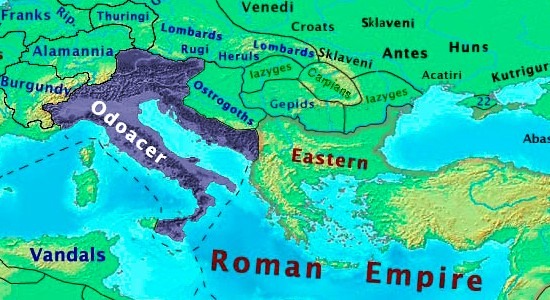
The Ostrogoths fought a long and hard war with the Eastern Romans, or Byzantines. It left both parties weakened and exhausted. Then the Lombards, a Germanic tribe from north of the Alps, overran the struggling Ostrogothic realm. The Lombards quickly adopted Roman customs, law, fashion, and even the deteriorating Vulgar Latin spoken in the region. Their legacy endures to this day, bestowing their name to the northern Italian region of Lombardy. Neither the Lombards nor the Ostrogoths completely conquered Italy, though: the Byzantine emperor managed to retain a degree of power and influence in southern Italy for centuries.
To Italy’s northwest, the Franks had established control over most of Gaul and started to look elsewhere for expansion. During the 750s, they attacked the Lombards and reorganized Italy as they saw fit. Charlemagne‘s father provided the pope – a rival of the Lombard king – with lands of his own. These lands were called the Papal States, essentially a strip from the Tyrrhenian to the Adriatic, cutting “Italy” in two. Over time, this created a cultural rift between north and south, with Rome and its surroundings acting as its midpoint – a gap that modern Italy is still trying to bridge.
In medieval terms, we colloquially refer to the inhabitants of the city-states to Rome’s north as Italians. During the Middle Ages themselves, these people were often generically, and just as scientifically incorrect, called “Lombards”. The southerners, for that matter, followed a rather different path, which we’ll cover on another page.
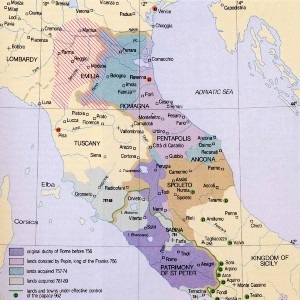
The Frankish Empire started to disintegrate during the 9th century. A century later, the Holy Roman Empire was formed as one of its “successor states”, with the Kingdom of Italy – that is, northern Italy – being one of its major building blocks. Indeed, the Holy Roman Empire came into being when the German king married the Italian queen in 951 CE. The imperial hold over Italy was tenuous at best, though. The region was still one of the most urbanized of Western Europe, which brought with it pride and power to resist the Holy Roman Emperors with.
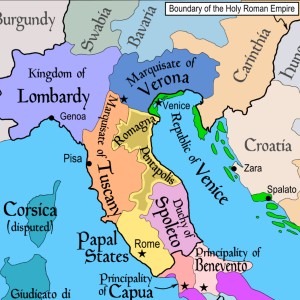
Thanks to its geography, Italy was excellently connected with both northern Europe and the whole of the Mediterranean. This made it an ideal commercial center. When the Crusades led to the establishment of new, christian realms in the Levant, the Italians were therefore in prime position to reap the mercantile rewards that followed. Their industries grew exponentially, with major cities like Genoa and Venice capitalizing on these newfound opportunities. Pisa, Florence and Milan followed suit, reinvigorating the surrounding villages by the growing agricultural demands of the cities’ expanding populations.
As the Italian cities grew richer through commerce, and the manufacturing of cloths from raw materials – whether it was Indian cotton, Chinese silk, or Spanish wool – they also became independent. By the 13th century, German control over most Italian cities was nominal. For instance, while Bologna remained in the Kaiser’s grip, Florence, Genoa, Milan and Venice, to name the foremost, reorganized themselves as republics. They thus distanced themselves from the feudal monarchies found in the rest of Europe. Although some republics did try and implement a certain degree of representation, it was clear that the aristocracy of artisans and tradesmen was in full control.
On account of their wealth, they were commonly referred to as popolo grasso – “fat people”.
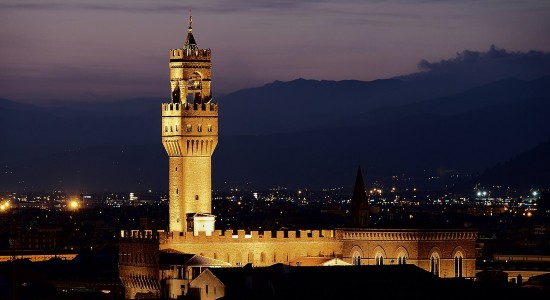
– advertisement –
– article continues below –
Traditionally, the Italian Renaissance of the 14th-15th centuries CE has been presented as the end of the Middle Ages, based on increased urbanization, the greater body of secular literature, and the artistic revolution in painting and sculpture.
Yet upon closer inspection, a precise definition of “the Renaissance” remains elusive – the term itself being problematic from the get-go, as it implies that the preceding period was “dead”.
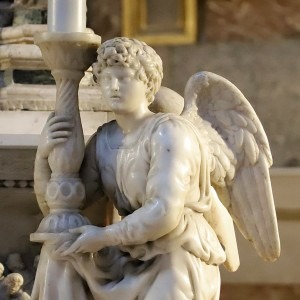
There are varying historiographical approaches that form a still ongoing academic debate. On the one hand, there are scholars that stress the Italian achievements and leadership in architecture, finance, science, literature, and arts during this period. Others defend the many points of continuity between the Late Middle Ages and the Renaissance. They point to the rise of towns and cities, the establishment of bureaucratic states, and the cultivation of trade links with Asia Minor and the Black Sea area – all of them trends that were already underway during the High Middle Ages. On top of that, rising socio-economic inequality was a feature of the Renaissance period that is often glossed over in order to reinforce the era’s association with progress and prosperity.
Ultimately, the truth is somewhere in between. It cannot be denied that the Italians made great progress during the Renaissance. But, as every new historical era builds upon the last, Renaissance Italy accelerated and catalyzed many trends that had been developing for quite some time. When the Middle Ages ended exactly, is therefore difficult to pinpoint. However, Italians who lived in the 14th and 15th centuries were part of societies that were gradually yet decidedly “less medieval” than before.
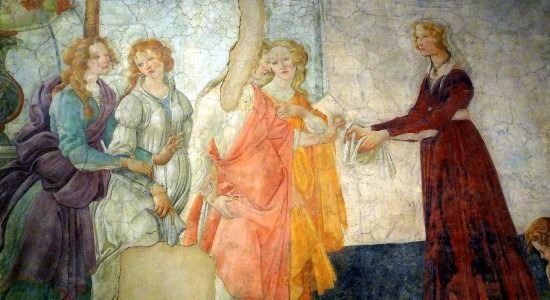
Disclosure: we work hard to provide you with exclusive medieval reports and guides. To make the Middle Ages accessible to everybody, we’d like this information to remain FREE. Therefore, some of the links below are affiliate links, meaning – at no additional cost to you – we will earn a small compensation if you click through.
Grab a short intro on another civilization from our Medieval Guidebook.
Featured Image Credit: Clément Bardo (Wikimedia)